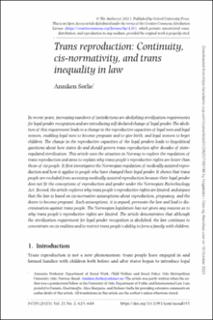| dc.contributor.author | Sørlie, Anniken | |
| dc.date.accessioned | 2023-10-20T11:54:17Z | |
| dc.date.available | 2023-10-20T11:54:17Z | |
| dc.date.created | 2023-08-25T13:47:52Z | |
| dc.date.issued | 2023 | |
| dc.identifier.citation | International Journal of Constitutional Law. 2023, 21 (2), 625-648. | en_US |
| dc.identifier.issn | 1474-2640 | |
| dc.identifier.uri | https://hdl.handle.net/11250/3097807 | |
| dc.description.abstract | In recent years, increasing numbers of jurisdictions are abolishing sterilization requirements
for legal gender recognition and are introducing self-declared change of legal gender. The aboli-
tion of this requirement leads to a change in the reproductive capacities of legal men and legal
women, enabling legal men to become pregnant and to give birth, and legal women to beget
children. The change in the reproductive capacities of the legal genders leads to biopolitical
questions about how states do and should govern trans reproduction after decades of state-
regulated sterilization. This article uses the situation in Norway to explore the regulation of
trans reproduction and aims to explain why trans people’s reproductive rights are lesser than
those of cis people. It first investigates the Norwegian regulation of medically assisted repro-
duction and how it applies to people who have changed their legal gender. It shows that trans
people are excluded from accessing medically assisted reproduction because their legal gender
does not fit the conceptions of reproduction and gender under the Norwegian Biotechnology
Act. Second, the article explores why trans people’s reproductive rights are limited, and argues
that the law is based on cis-normative assumptions about reproduction, pregnancy, and the
desire to become pregnant. Such assumptions, it is argued, permeate the law and lead to dis-
crimination against trans people. The Norwegian legislature has not given any reasons as to
why trans people’s reproductive rights are limited. The article demonstrates that although
the sterilization requirement for legal gender recognition is abolished, the law continues to
concentrate on cis realities and to restrict trans people’s ability to form a family with children. | en_US |
| dc.language.iso | eng | en_US |
| dc.rights | Navngivelse 4.0 Internasjonal | * |
| dc.rights.uri | http://creativecommons.org/licenses/by/4.0/deed.no | * |
| dc.title | Trans reproduction: Continuity, cis-normativity, and trans inequality in law | en_US |
| dc.type | Peer reviewed | en_US |
| dc.type | Journal article | en_US |
| dc.description.version | publishedVersion | en_US |
| cristin.ispublished | true | |
| cristin.fulltext | original | |
| cristin.qualitycode | 2 | |
| dc.identifier.doi | 10.1093/icon/moad055 | |
| dc.identifier.cristin | 2169705 | |
| dc.source.journal | International Journal of Constitutional Law | en_US |
| dc.source.volume | 21 | en_US |
| dc.source.issue | 2 | en_US |
| dc.source.pagenumber | 625-648 | en_US |

